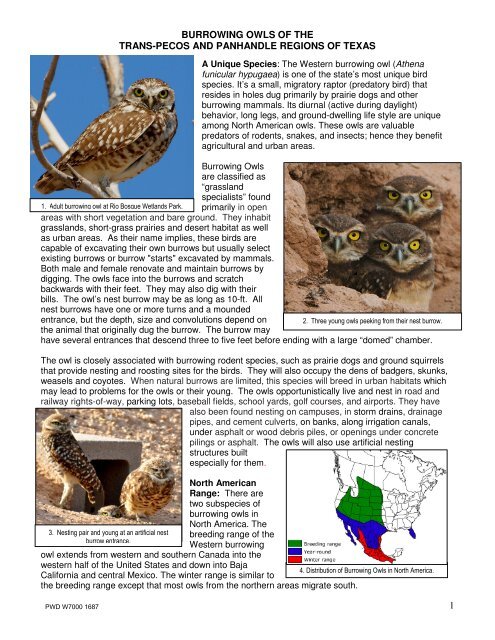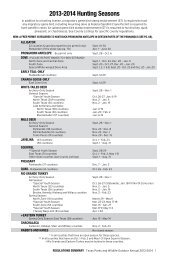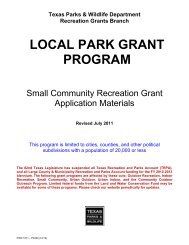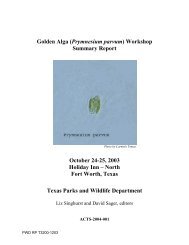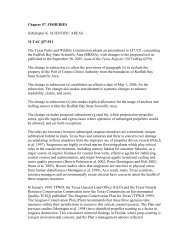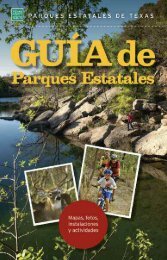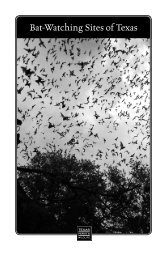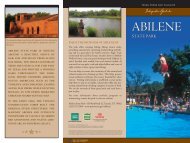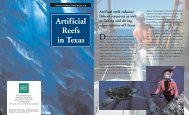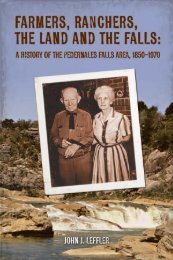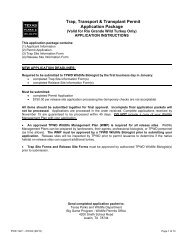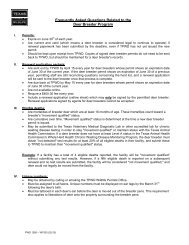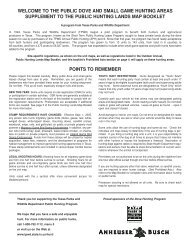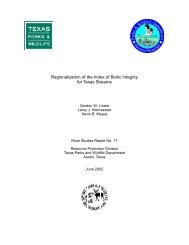1 burrowing owls of the trans-pecos and panhandle regions of texas
1 burrowing owls of the trans-pecos and panhandle regions of texas
1 burrowing owls of the trans-pecos and panhandle regions of texas
Create successful ePaper yourself
Turn your PDF publications into a flip-book with our unique Google optimized e-Paper software.
BURROWING OWLS OF THE<br />
TRANS-PECOS AND PANHANDLE REGIONS OF TEXAS<br />
A Unique Species: The Western <strong>burrowing</strong> owl (A<strong>the</strong>na<br />
funicular hypugaea) is one <strong>of</strong> <strong>the</strong> state’s most unique bird<br />
species. It’s a small, migratory raptor (predatory bird) that<br />
resides in holes dug primarily by prairie dogs <strong>and</strong> o<strong>the</strong>r<br />
<strong>burrowing</strong> mammals. Its diurnal (active during daylight)<br />
behavior, long legs, <strong>and</strong> ground-dwelling life style are unique<br />
among North American <strong>owls</strong>. These <strong>owls</strong> are valuable<br />
predators <strong>of</strong> rodents, snakes, <strong>and</strong> insects; hence <strong>the</strong>y benefit<br />
agricultural <strong>and</strong> urban areas.<br />
Burrowing Owls<br />
are classified as<br />
“grassl<strong>and</strong><br />
specialists” found<br />
1. Adult <strong>burrowing</strong> owl at Rio Bosque Wetl<strong>and</strong>s Park. primarily in open<br />
areas with short vegetation <strong>and</strong> bare ground. They inhabit<br />
grassl<strong>and</strong>s, short-grass prairies <strong>and</strong> desert habitat as well<br />
as urban areas. As <strong>the</strong>ir name implies, <strong>the</strong>se birds are<br />
capable <strong>of</strong> excavating <strong>the</strong>ir own burrows but usually select<br />
existing burrows or burrow "starts" excavated by mammals.<br />
Both male <strong>and</strong> female renovate <strong>and</strong> maintain burrows by<br />
digging. The <strong>owls</strong> face into <strong>the</strong> burrows <strong>and</strong> scratch<br />
1<br />
backwards with <strong>the</strong>ir feet. They may also dig with <strong>the</strong>ir<br />
bills. The owl’s nest burrow may be as long as 10-ft. All<br />
nest burrows have one or more turns <strong>and</strong> a mounded<br />
entrance, but <strong>the</strong> depth, size <strong>and</strong> convolutions depend on<br />
<strong>the</strong> animal that originally dug <strong>the</strong> burrow. The burrow may<br />
have several entrances that descend three to five feet before ending with a large “domed” chamber.<br />
The owl is closely associated with <strong>burrowing</strong> rodent species, such as prairie dogs <strong>and</strong> ground squirrels<br />
that provide nesting <strong>and</strong> roosting sites for <strong>the</strong> birds. They will also occupy <strong>the</strong> dens <strong>of</strong> badgers, skunks,<br />
weasels <strong>and</strong> coyotes. When natural burrows are limited, this species will breed in urban habitats which<br />
may lead to problems for <strong>the</strong> <strong>owls</strong> or <strong>the</strong>ir young. The <strong>owls</strong> opportunistically live <strong>and</strong> nest in road <strong>and</strong><br />
railway rights-<strong>of</strong>-way, parking lots, baseball fields, school yards, golf courses, <strong>and</strong> airports. They have<br />
also been found nesting on campuses, in storm drains, drainage<br />
pipes, <strong>and</strong> cement culverts, on banks, along irrigation canals,<br />
under asphalt or wood debris piles, or openings under concrete<br />
pilings or asphalt. The <strong>owls</strong> will also use artificial nesting<br />
structures built<br />
especially for <strong>the</strong>m.<br />
3. Nesting pair <strong>and</strong> young at an artificial nest<br />
burrow entrance.<br />
North American<br />
Range: There are<br />
two subspecies <strong>of</strong><br />
<strong>burrowing</strong> <strong>owls</strong> in<br />
North America. The<br />
breeding range <strong>of</strong> <strong>the</strong><br />
Western <strong>burrowing</strong><br />
owl extends from western <strong>and</strong> sou<strong>the</strong>rn Canada into <strong>the</strong><br />
western half <strong>of</strong> <strong>the</strong> United States <strong>and</strong> down into Baja<br />
California <strong>and</strong> central Mexico. The winter range is similar to<br />
<strong>the</strong> breeding range except that most <strong>owls</strong> from <strong>the</strong> nor<strong>the</strong>rn areas migrate south.<br />
2. Three young <strong>owls</strong> peeking from <strong>the</strong>ir nest burrow.<br />
4. Distribution <strong>of</strong> Burrowing Owls in North America.<br />
America<br />
PWD W7000 1687<br />
1
Distribution in TX: Burrowing <strong>owls</strong> mainly breed in <strong>the</strong><br />
Trans-Pecos <strong>and</strong> Panh<strong>and</strong>le (Rolling Hills <strong>and</strong> High Plains)<br />
ecological <strong>regions</strong> <strong>of</strong> West Texas but may winter<br />
throughout most <strong>of</strong> Texas. Data obtained from <strong>the</strong> Texas<br />
Breeding Bird Association shows <strong>the</strong> largest concentration<br />
<strong>of</strong> confirmed breeding <strong>owls</strong> is in <strong>the</strong> High Plains region.<br />
Some <strong>owls</strong> w<strong>and</strong>er extensively during <strong>the</strong> winter while<br />
o<strong>the</strong>rs migrate. Time <strong>of</strong> departure is from August through<br />
September <strong>and</strong> arrival time within <strong>the</strong> breeding range is in<br />
mid-March.<br />
6. Adult owl guarding burrow <strong>and</strong> young.<br />
Description:<br />
Burrowing <strong>owls</strong><br />
are a mediumsize<br />
bird<br />
approximately 9<br />
inches tall with a<br />
5. Distribution <strong>of</strong> breeding <strong>and</strong> wintering <strong>burrowing</strong> <strong>owls</strong> in<br />
Texas.<br />
wingspan <strong>of</strong> 20-24 inches. This species exhibit sexual<br />
dimorphism; female <strong>owls</strong> are smaller <strong>and</strong> usually darker than<br />
males. The fea<strong>the</strong>rs are a s<strong>and</strong>y brown color above, while <strong>the</strong><br />
breast area is beige with spotted bars. Its long legs, short tail,<br />
white eyebrows, along with its brilliant yellow eyes, <strong>and</strong> lack <strong>of</strong><br />
ear tufts, are distinctive. Juvenile <strong>owls</strong> lack chest bars. The long legs are unique among <strong>owls</strong> <strong>and</strong> are<br />
adapted for its ground-dwelling life style. Burrowing Owls <strong>of</strong>ten live socially in loose colonies, with adults<br />
st<strong>and</strong>ing guard near nest burrows. The birds produce a variety <strong>of</strong> calls. The male gives <strong>the</strong> primary<br />
songs (mate attraction <strong>and</strong> territorial calls), described as “coo-coo.” O<strong>the</strong>r calls include distress <strong>and</strong><br />
warning calls (“chuck” <strong>and</strong> “chatter”) <strong>and</strong> mating calls. Their vocal repertoire also includes screams <strong>and</strong><br />
raspy calls.<br />
Habitat: Burrowing Owls characteristically inhabit<br />
open areas with short vegetation, bare ground,<br />
well-drained soil <strong>and</strong> areas with a level to gentlysloped<br />
incline. They use a wide array <strong>of</strong> arid <strong>and</strong><br />
semi-arid environments including deserts, desert<br />
grassl<strong>and</strong>s, scrub <strong>and</strong> shrub-l<strong>and</strong>s that contain<br />
creosote bush, mesquite, four-wing saltbush, <strong>and</strong><br />
rabbit-brush. They also inhabit juniper savanna,<br />
plains-mesa grassl<strong>and</strong>s, <strong>and</strong> s<strong>and</strong> scrub, s<strong>and</strong><br />
dunes, pasture, hay, farm <strong>and</strong> fallow fields. Their<br />
presence is limited to areas<br />
where natural cavities or<br />
colonial <strong>burrowing</strong> rodents (black-tailed prairie dogs, ground squirrels) dwell.<br />
Nesting in areas <strong>of</strong> short vegetation allows <strong>the</strong> <strong>owls</strong> to see possible ground<br />
predators approaching <strong>the</strong> nest.<br />
7. Adult owl guarding young in at entrance its burrow in an arroyo.<br />
8. Juvenile with snake<br />
on <strong>the</strong> menu.<br />
Diet: Burrowing Owls are generalist predators with unique feeding habits. This<br />
bird has <strong>the</strong> distinction <strong>of</strong> being <strong>the</strong> only daytime-feeding owl. These <strong>owls</strong> may<br />
actively feed during <strong>the</strong> day (diurnal) <strong>and</strong> night (nocturnal), especially during <strong>the</strong><br />
breeding season; however most feeding activity occurs at dawn <strong>and</strong> dusk<br />
(crepuscular). Unlike o<strong>the</strong>r nocturnal <strong>owls</strong>, <strong>the</strong>y feed primarily on arthropods<br />
(insects) <strong>and</strong> small vertebrates. The birds hunt small mammals, birds, reptiles<br />
<strong>and</strong> amphibians. Hunting methods include swooping down from a perch,<br />
hovering over open areas, running along <strong>the</strong> ground, <strong>and</strong> "hawking" (catching<br />
insects in flight). Prey is usually caught by sharp talons (claws); however, small<br />
prey items may be pounced on <strong>and</strong> crushed by <strong>the</strong>ir bills.<br />
2
Predators: Mammalian predators include badgers, bobcats, weasels, skunks, coyote, domestic cats <strong>and</strong><br />
dogs. Avian (bird) predators include golden eagles, hawks (Swainson’s, ferruginous, red-tailed, <strong>and</strong><br />
Cooper’s), Merlin, prairie, <strong>and</strong> peregrine falcons, Nor<strong>the</strong>rn harriers, great-horned <strong>and</strong> barn <strong>owls</strong> as well<br />
as American Crows. Snakes will also take <strong>owls</strong>. This bird has one remarkable predatory defense<br />
mechanism; <strong>the</strong>y have <strong>the</strong> ability to perfectly mimic <strong>the</strong> rattling sound <strong>of</strong> a prairie rattlesnake.<br />
Breeding Biology.<br />
Pair-bonding/Nest building: Burrowing <strong>owls</strong> are thought to be seasonally monogamous (pairing<br />
between one female <strong>and</strong> one male), forming pair bonds mainly during <strong>the</strong> nesting season. Breeding<br />
occurs from mid-March through September. Before nesting, <strong>the</strong> male prepares <strong>the</strong> nest site by<br />
improving or enlarging <strong>the</strong> burrow. The <strong>owls</strong> <strong>trans</strong>port a sufficient pile <strong>of</strong> dried horse or cow manure to<br />
<strong>the</strong> burrow entrance, shred <strong>the</strong> materials <strong>and</strong> carry it into <strong>the</strong> burrow.<br />
Nest chamber floors may be lined approximately 1-in deep with<br />
shredded dung. The tunnel <strong>and</strong> entrances are usually also lined. This<br />
practice may serve to provide egg insulation, camouflage <strong>the</strong> <strong>owls</strong>' scent<br />
from predators, absorb water to reduce flooding within <strong>the</strong> nest, or attract<br />
invertebrates which <strong>the</strong> <strong>owls</strong> catch <strong>and</strong> feed to <strong>the</strong>ir young. Nesting<br />
densities vary from ten pairs per 0.6-mi² in optimal habitat to one pair per<br />
22-mi² in poor quality habitat<br />
9. Pair bonding.<br />
Incubation. The average clutch size is 6-7 eggs. Incubation lasts for<br />
28-30 days. The female usually stays with <strong>the</strong> nest during incubation<br />
while <strong>the</strong> male st<strong>and</strong>s guards at <strong>the</strong><br />
nest. The male is <strong>the</strong> sole food<br />
provider during incubation <strong>and</strong><br />
before <strong>the</strong> young emerge from <strong>the</strong><br />
burrow.<br />
Nestlings/Fledglings. The female joins in provisioning when <strong>the</strong><br />
young (2-3 weeks old) emerge from <strong>the</strong> burrow for extended<br />
periods. The nestlings (baby birds) are tended to by both parents<br />
<strong>and</strong> fledge (acquire flight fea<strong>the</strong>rs) about 4 weeks after hatching.<br />
The fledglings are capable <strong>of</strong> flight at 6 weeks <strong>of</strong> age. Owl families<br />
<strong>of</strong>ten switch burrows every 10-15 days when <strong>the</strong> young fledge <strong>and</strong><br />
<strong>the</strong>y remain as a loose-knit group until early fall when <strong>the</strong> young<br />
begin dispersing to nearby burrows. The young feed primarily on<br />
insects <strong>and</strong> work on <strong>the</strong>ir predatory skills by pouncing on dead or live insects.<br />
10. Three <strong>burrowing</strong> owl nestlings.<br />
12. Six <strong>burrowing</strong> owl nestlings at a natural burrow in an arroyo.<br />
11. Adult <strong>and</strong> three nestlings at natural burrow in an arroyo.<br />
3
Legal Status<br />
Over <strong>the</strong> past century, black-tailed prairie dog populations have been reduced by 90-98% through<br />
eradication programs, habitat loss <strong>and</strong> fragmentation, <strong>and</strong> <strong>the</strong> Sylvatic plague. As <strong>the</strong> prairie dog<br />
numbers declined, so did <strong>burrowing</strong> owl numbers. Currently <strong>the</strong>y are listed as a Species <strong>of</strong> International<br />
Conservation Concern, Endangered in Canada, Threatened in Mexico, <strong>and</strong> a Bird <strong>of</strong> National<br />
Conservation Concern by <strong>the</strong> U.S. Fish <strong>and</strong> Wildlife Service (USFWS). The <strong>owls</strong> are a Species <strong>of</strong><br />
Concern in 9 U.S. states, 3 USFWS <strong>regions</strong>, 9 Bird Conservation Regions <strong>and</strong> rated as a Species <strong>of</strong><br />
Regional Importance (Trans-Pecos) by Partners in Flight.<br />
Conservation <strong>of</strong> <strong>the</strong> Burrowing Owl. The widespread control <strong>of</strong> <strong>burrowing</strong> mammals is <strong>the</strong> leading<br />
cause <strong>of</strong> decline for <strong>burrowing</strong><br />
<strong>owls</strong> <strong>and</strong> <strong>the</strong> black-footed<br />
ferret, one <strong>of</strong> <strong>the</strong> most<br />
endangered species in <strong>the</strong><br />
world that depends on prairie<br />
dogs for <strong>the</strong>ir survival. Of <strong>the</strong><br />
700,000,000 acres <strong>of</strong> prairie<br />
dog habitat that existed in<br />
1900, less than 2,000,000 exist<br />
today. Natural <strong>burrowing</strong> owl<br />
habitat <strong>and</strong> populations <strong>of</strong><br />
<strong>burrowing</strong> mammals are<br />
ultimately critical for <strong>the</strong><br />
conservation <strong>of</strong> this species.<br />
With <strong>the</strong> preservation <strong>of</strong> native<br />
grassl<strong>and</strong>s, prairies, <strong>and</strong><br />
13. Group <strong>of</strong> juveniles in a <strong>burrowing</strong> owl family.<br />
deserts <strong>and</strong> protection <strong>of</strong> <strong>burrowing</strong> mammals, we can retain this unique species for <strong>the</strong> viewing by future<br />
generations.<br />
Management Practices: Today <strong>the</strong>se birds <strong>of</strong>ten reside in close proximity to humans. You may see<br />
<strong>the</strong>m nesting or wintering in urban areas like <strong>the</strong> arroyo behind your house in your neighborhood, <strong>the</strong><br />
ab<strong>and</strong>oned lot near <strong>the</strong> <strong>of</strong>fice, or <strong>the</strong> park where you jog. As our communities grow <strong>and</strong> habitat patches<br />
are developed, burrows are being destroyed. Note that this species is<br />
valuable to humans <strong>and</strong> <strong>the</strong> ecosystem. They consume small rodents<br />
such as mice <strong>and</strong> pocket gophers <strong>and</strong> prevent outbreaks <strong>of</strong> insects<br />
<strong>and</strong> invertebrates such as locusts, grasshoppers, beetles, crickets,<br />
scorpions, <strong>and</strong> earwigs.<br />
Practical Actions to Help Burrowing Owls:<br />
1) Conduct activities outside <strong>the</strong> breeding season (March to<br />
September). Nesting areas <strong>and</strong> burrows should be protected<br />
from intensive disturbance during incubation. Excavation <strong>of</strong> an<br />
active nest burrow may destroy eggs, young <strong>owls</strong>, or even<br />
adults <strong>and</strong> is violation <strong>of</strong> <strong>the</strong> Migratory Bird Treaty Act.<br />
2) Use caution when spraying pesticides; keep > 250 meters<br />
away from nest sites; use <strong>the</strong> least harmful chemicals <strong>and</strong><br />
encourage your county or municipality not to spray ditches<br />
close to owl nests. Learn to appreciate grasshoppers (most<br />
aren’t pests).<br />
3) Keep dogs on leases, <strong>the</strong>y <strong>of</strong>ten will dig out <strong>the</strong> nest <strong>and</strong><br />
14. Young <strong>owls</strong> almost ready to fledge.<br />
remove chicks.<br />
4) Keep cats indoors or leashed; cats will kill <strong>owls</strong>.<br />
5) Support a removal program for all feral dogs <strong>and</strong> cats on public l<strong>and</strong>s<br />
4
6) Support restriction <strong>of</strong> recreational <strong>of</strong>f-road vehicle uses in <strong>burrowing</strong> owl habitat. Owl burrows<br />
may collapse. Compacted soils negatively affect habitat quality; noise may disturb <strong>the</strong> <strong>owls</strong>.<br />
7) Support l<strong>and</strong> use st<strong>and</strong>ards, natural open space planning, habitat stewardship, <strong>and</strong> habitat<br />
enhancement projects that benefit <strong>burrowing</strong> <strong>owls</strong>.<br />
8) Provide artificial nest burrows whenever possible;<br />
<strong>the</strong>y provide nesting habitat where mammal burrows<br />
are limited due to prairie dog eradication, or where<br />
<strong>owls</strong> have been evicted from natural burrows, <strong>and</strong> in<br />
reintroduction efforts.<br />
9) Remember to observe <strong>owls</strong> from a respectful<br />
distance.<br />
10) Participate in local organized efforts at monitoring<br />
reproduction <strong>of</strong> <strong>the</strong> <strong>owls</strong>.<br />
How You Can Help. Play a role in <strong>the</strong> conservation <strong>and</strong><br />
recovery <strong>of</strong> <strong>the</strong> Burrowing Owl. If you encounter an owl,<br />
<strong>the</strong> following positive actions may be taken:<br />
1) Report any birds found nesting or near construction<br />
sites to your local USFWS agent or Texas Parks <strong>and</strong><br />
Wildlife Biologist.<br />
2) Encourage<br />
developers,<br />
construction<br />
managers <strong>and</strong><br />
businesses to provide protective barriers around <strong>the</strong> nest<br />
site <strong>and</strong> to mitigate lost owl habitat. Mitigation measures<br />
should include avoiding impacts if feasible, avoiding<br />
disturbance <strong>of</strong> <strong>owls</strong> during <strong>the</strong> breeding season, protecting<br />
sufficient foraging habitat, <strong>and</strong> enhancing existing habitat<br />
with artificial nest burrows where possible.<br />
3) Provide posts or poles > four feet tall in or near Burrowing<br />
Owl habitat for hunting, perching <strong>and</strong> predator detection.<br />
4) Encourage local golf<br />
courses <strong>and</strong> city parks to<br />
help restore Burrowing Owl<br />
populations by providing<br />
artificial nest burrows in<br />
16. Adult perched on rebar.<br />
entrance<br />
suitable non-maintained<br />
areas >150 feet from <strong>the</strong><br />
nearest irrigation system. The <strong>owls</strong> provide free pest control <strong>of</strong><br />
small rodents <strong>and</strong> insects.<br />
5) In agricultural farming areas, practice good cattle-grazing grass<br />
management <strong>and</strong> provide stable artificial burrows. Active owl<br />
burrows near trails <strong>and</strong> along canal banks in agricultural areas<br />
are susceptible to collapse from heavy farm equipment.<br />
6) Maintain prairie dogs, ground squirrels <strong>and</strong> badger populations;<br />
<strong>the</strong>y are <strong>the</strong> key to providing nesting burrows for <strong>burrowing</strong> <strong>owls</strong>.<br />
7) Leave ditches un-mowed; keep whatever grassy areas you have<br />
<strong>and</strong> seed pastures, roadsides <strong>and</strong> right-<strong>of</strong>-ways with native<br />
grasses.<br />
8) Plant new trees at least one mile from owl nesting areas.<br />
9) Leave a small swath <strong>of</strong> crop or hay near owl nests for mice, one <strong>of</strong> <strong>the</strong>ir food sources.<br />
15. Burrowing owl at artificial burrow entrance.<br />
17. Owl perched on a wooden post.<br />
10) Avoid cultivating over any active nests; nests will be destroyed <strong>and</strong> may bury <strong>the</strong> female inside.<br />
11) Share <strong>the</strong> news <strong>of</strong> your <strong>owls</strong> with neighbors <strong>and</strong> people who use your l<strong>and</strong>.<br />
12) Join many <strong>of</strong> your neighbors in conservation easement agreements.<br />
5
Recommendations. Installing artificial burrows is one conservation measure that may help maintain<br />
local Burrowing Owl populations. Only construct artificial nest burrows with <strong>the</strong> aid <strong>of</strong> a wildlife biologist<br />
to ensure success for <strong>the</strong> <strong>owls</strong>. Late September through early February is <strong>the</strong> optimal time for<br />
installation. Occupation is unlikely to occur until March when <strong>the</strong> <strong>owls</strong> return from migration <strong>and</strong> search<br />
for burrows. There are numerous ways to create artificial burrows. Research methods <strong>of</strong> constructing<br />
nest burrows appropriate to your ecological region <strong>and</strong> habitat type. Information is available on <strong>the</strong><br />
internet or with your local wildlife agency.<br />
18. Finished installation <strong>of</strong> an artificial burrow at<br />
<strong>the</strong> community college entrance.<br />
20' Schedule 40 PVC pipe (need 16' per burrow),<br />
90-degree elbows for 4" pipe (need 2/burrow), 12"<br />
x 17" or 14” x 18” green plastic valve box, <strong>and</strong> 8" x<br />
8" x 8" half cinder block (2 for each burrow). If<br />
your site has good drainage, <strong>the</strong> chamber <strong>and</strong><br />
connecting pipes may be laid out on <strong>the</strong> ground<br />
surface <strong>and</strong> soil piled on top <strong>of</strong> <strong>the</strong>m. If drainage is<br />
a problem, build <strong>the</strong> mound first, <strong>and</strong> <strong>the</strong>n dig<br />
trenches for <strong>the</strong> chamber <strong>and</strong> pipes. This will<br />
ensure that <strong>the</strong> chamber is above <strong>the</strong> existing<br />
grade. The connecting pipes may be angled<br />
downward to prevent water getting into <strong>the</strong> pipes.<br />
Criteria for Selecting <strong>the</strong> Right Site:<br />
• Approximately 55% (40-70%) bare ground <strong>and</strong> average<br />
shrub coverage <strong>of</strong>
nesting areas if dung is not available <strong>and</strong> mammalian predators occur in <strong>the</strong> area. Barbed wire or o<strong>the</strong>r<br />
materials may also be placed over <strong>the</strong> nest chamber to restrain digging attempts by predators.<br />
PHOTO CREDITS<br />
1. Photo number 1<br />
Provided: Lois Balin<br />
Photographer: Joe Grossinger<br />
Contact info: Lila & Joe Grossinger Photography<br />
time/camera: Sony DSLR-A350.<br />
Location: Rio Bosque Wetl<strong>and</strong>s Park, El Paso<br />
Date: 7/1/2009<br />
Description: Adult <strong>burrowing</strong> owl at Rio Bosque Wetl<strong>and</strong>s Park<br />
2. Photo number 2<br />
Provided by: Lois Balin<br />
Photographer: L<strong>and</strong>is L. Hinesley<br />
Contact info: DBA Nature’s Image Photography<br />
Time/Camera: 6:13 PM, Nikon D300 Camera<br />
Location: Las Cruces, Dona Ana County, New Mexico<br />
Date: August 2009<br />
Description: Three young <strong>owls</strong> peeking from <strong>the</strong> nest burrow.<br />
3. Photo number 3<br />
Provided by: Lois Balin<br />
Job title/contact info: Wildlife Biologist, lois.balin@tpwd.state.tx.us, 915 774-9603<br />
Photographer: Joe Grossinger<br />
Contact info: Lila & Joe Grossinger Photography<br />
time/camera: Sony DSLR-A350.<br />
Location: Rio Bosque Wetl<strong>and</strong>s Park, El Paso<br />
Date: 7/01/09<br />
Description: Nesting pair at artificial nest burrow entrance<br />
4. Diagram number 4<br />
Provided by: Lois Balin<br />
Title/contact: Wildlife Biologist, lois.balin@tpwd.state.tx.us, 915 774-9603<br />
Wildlife <strong>and</strong> Ecosystem Protection, Species At Risk Burrowing Owl Fact Sheet<br />
mgi@gov.mb.ca http://www.gov.mb.ca/conservation/wildlife/sar/fs/burowl.html<br />
5. Diagram number 5<br />
Provided by: Mark Lockwood<br />
Job Title: Texas Parks <strong>and</strong> Wildlife, Natural Resource Program, mark.lockwood@tpwd.state.tx.us<br />
Range map <strong>of</strong> <strong>burrowing</strong> owl in Texas. Lockwood, M. W. <strong>and</strong> B. Freeman. 2004. The TOS H<strong>and</strong>book <strong>of</strong><br />
Texas Birds. Texas A&M University Press, College Station, Texas.<br />
6. Photo number 6<br />
Provided by: Lois Balin<br />
Photographer: L<strong>and</strong>is L. Hinesley<br />
Contact info: DBA Nature’s Image Photography<br />
Time/Camera: 6:35 PM, Nikon D300 Camera<br />
Location: Las Cruces, Dona Ana County, New Mexico<br />
Date: August 2009<br />
Description: Adult owl guarding burrow <strong>and</strong> young<br />
7. Photo number 7<br />
7
Provided by: Lois Balin<br />
Photographer: James N. Stuart<br />
Camera: Canon EOS 40D<br />
Location: Rio Rancho, NM<br />
Date: May 2008<br />
Description: Adult owl guarding young in at entrance its burrow in an arroyo<br />
8. Photo number 8<br />
Provided by: Lois Balin<br />
Contact info: bail56@hur.midco.net<br />
Photographer: Chris Bailey<br />
Camera: Cannon EOS 400<br />
Location: Beadle County, South Dakota<br />
Date: June 2009<br />
Description: Snake is on <strong>the</strong> menu today.<br />
9. Photo number 9<br />
Provided by: Lois Balin<br />
Contact info: bail56@hur.midco.net<br />
Photographer: Chris Bailey<br />
Camera: Cannon EOS 400<br />
Location: Beadle County, South Dakota<br />
Date: June 2009<br />
Description: Pair bonding<br />
10. Photo number 10<br />
Provided by: Lois Balin<br />
Contact info: bail56@hur.midco.net<br />
Photographer: Chris Bailey<br />
Camera: Cannon EOS 400<br />
Location: Beadle County, South Dakota<br />
Date: June 2009<br />
Description: Three <strong>burrowing</strong> owl nestlings<br />
11. Photo number 11<br />
Provided by: Lois Balin<br />
Photographer: Michael Bruce<br />
Camera: Canon EOS Digital Rebel XTi.<br />
Location: Albuquerque, New Mexico<br />
Date: June 2009<br />
Description Adult <strong>and</strong> three nestlings at a natural burrow in an arroyo<br />
12. Photo number 12<br />
Provided by: Lois Balin<br />
Photographer: L<strong>and</strong>is L. Hinesley<br />
Contact info: DBA Nature’s Image Photography<br />
Time/Camera: 7:02pm, Nikon D300 Camera<br />
Location: Las Cruces, Dona Ana County, New Mexico<br />
Date: August 2009<br />
Description: Six <strong>burrowing</strong> owl nestlings at a natural burrow in an arroyo.<br />
13. Photo number 13<br />
Provided by: Lois Balin<br />
Contact info: bail56@hur.midco.net<br />
8
Photographer: Chris Bailey<br />
Camera: Cannon EOS 400<br />
Location: Beadle County, South Dakota<br />
Date: July 2009<br />
Description: Group <strong>of</strong> juveniles in a <strong>burrowing</strong> owl family<br />
14. Photo number 14<br />
Provided by: Lois Balin<br />
Photographer: L<strong>and</strong>is L. Hinesley<br />
Contact info: DBA Nature’s Image Photography<br />
Time/Camera: 7:02pm, Nikon D300 Camera<br />
Location: Las Cruces, Dona Ana County, New Mexico<br />
Date: August 2009<br />
Description: Young <strong>owls</strong> almost ready to fledge<br />
15. Photo number 15<br />
Provided by: Lois Balin<br />
Photographer: Lois Balin<br />
Job title/contact info: Wildlife Biologist, lois.balin@tpwd.state.tx.us<br />
Time/camera: Canon EOS Digital Rebel<br />
Location: Rio Bosque Wetl<strong>and</strong>s Park, El Paso, TX<br />
Date: May, 2009<br />
Description: Burrowing owl at artificial burrow entrance<br />
16. Photo number 16<br />
Provided by: Lois Balin<br />
Photographer: James N. Stuart<br />
Camera: Canon EOS 40D<br />
Location: Rio Rancho, NM<br />
Date: May 2008<br />
Description: Adult perched on rebar<br />
17. Photo number 17<br />
Provided by (Name): Lois Balin<br />
Photographer: Robert Walburger<br />
Time/Camera: 4:48 pm, Canon Rebel XSi<br />
Location: Sou<strong>the</strong>rn Alberta, Canada<br />
Date: July, 2009<br />
Description: Owl perched on a post<br />
18. Photo number 18<br />
Provided by (Name): Lois Balin<br />
Contact info: Urban Wildlife Biologist; lois.balin@tpwd.state.tx.us<br />
Photographer: Diana Dominguez<br />
Time/Camera: 10:08 a.m., Panasonic Lumex<br />
Location: Mission del Paso, El Paso Community College<br />
Date: February, 2009<br />
Description: Finished installation <strong>of</strong> an artificial burrow at <strong>the</strong> community college<br />
19. Photo number 19<br />
Provided by (Name): Lois Balin<br />
Contact info: Urban Wildlife Biologist; lois.balin@tpwd.state.tx.us<br />
Photographer: John Sproul<br />
9
Location: Rio Bosque Wetl<strong>and</strong>s Park, El Paso, TX<br />
Date: May, 2008<br />
Description: Layout <strong>of</strong> uninstalled artificial nest burrow materials<br />
20. Photo number 20<br />
Provided by (Name): Lois Balin<br />
Photographer (Name): Lois Balin<br />
Job title/contact info: Urban Wildlife Biologist; lois.balin@tpwd.state.tx.us<br />
Time/ Camera: 8:00 a.m., Panasonic Lumex<br />
Location: San Elizario Independent School District Administration Building, TX<br />
Date: February, 2008<br />
Description: El Paso Zoo crew installing artificial nest burrows<br />
LITERATURE REVIEW<br />
Bates, C. California Partners in Flight Desert Bird Conservation Plan. Bureau <strong>of</strong> L<strong>and</strong> Management,<br />
Colorado River District, Lake Havasu City, AZ<br />
Butts, Kenneth O. 1976. Burrowing Owls Wintering in <strong>the</strong> Oklahoma Panh<strong>and</strong>le. The Auk, Vol. 93: 510-<br />
516<br />
Chipman, E.D. 2005. Behavioral Ecology <strong>of</strong> Western Burrowing Owls (A<strong>the</strong>ne cunicularia hypugaea) in<br />
Northwestern Texas, B.S. A Thesis in Biology, Texas Tech University<br />
Collins, C. T., <strong>and</strong> R. E. L<strong>and</strong>ry. 1977. Artificial Nest Burrows for Burrowing Owls. North American Bird<br />
B<strong>and</strong>er, Vol. 2:151-154.<br />
Conway, C.J., M.D. Smith. <strong>and</strong> L.A. Ellis. 2002. How to Install Artificial Nesting Burrows for Burrowing<br />
Owls, A Guide for Golf Course Superintendents <strong>and</strong> Grounds Crews<br />
Conway, C.J. <strong>and</strong> C.A. Finley. 2005. DOD Legacy Project: Migratory Linkages <strong>of</strong> Burrowing Owls.<br />
USGS Arizona Coop. Research Unit, University <strong>of</strong> Arizona, Tucson<br />
Damon L. Williford, Marc C. Woodin, Mary Kay Scorpio, <strong>and</strong> Graham C. Hickman. 2000. Rodents New to<br />
<strong>the</strong> Diet <strong>of</strong> <strong>the</strong> Western Burrowing Owl (A<strong>the</strong>na Funicular Hypogeal). Department <strong>of</strong> Life Sciences,<br />
Texas A&M University-Corpus Christi, TX, United States Geological Survey, Texas Gulf Coast Field<br />
Research Station, Corpus Christi, TX 78412<br />
Desmond M.J., J.A. Savidge, K.M. Eskridge. Correlations between Burrowing Owl <strong>and</strong> Black-tailed<br />
Prairie Dog Declines: a 7 Year Analysis. J. Wildlife Management, Vol. 64:1067–1075.<br />
Desmond M.J., J.A. Savidge. 1996. Factors Influencing Burrowing Owl (Speotyto cunicularia) Nest<br />
Densities <strong>and</strong> Numbers in Western Nebraska. Am. Midl<strong>and</strong> Nat., Vol. 136:143-148<br />
Desmond, M.J., J.A. Savidge, <strong>and</strong> T.F. Seibert. 1995. Spatial patterns <strong>of</strong> <strong>burrowing</strong> owl (Speotyto<br />
cunicularia) nests within black-tailed prairie dog (Cynomys ludovicianus) towns. Canadian Journal <strong>of</strong><br />
Zoology 73:1375-1379.<br />
Haug, E. A., <strong>and</strong> A. B. Didiuk. 1993. Detection <strong>of</strong> Burrowing Owls. J. Field Ornithology, Vol. 64:189<br />
Hawks Al<strong>of</strong>t, Inc. New Mexico Burrowing Owl Working Group, P.O. Box 10028, Albuquerque, New<br />
Mexico 87184.<br />
.<br />
10
Lockwood, M. W. <strong>and</strong> B. Freeman. 2004. The TOS H<strong>and</strong>book <strong>of</strong> Texas Birds. Texas A&M University<br />
Press, College Station.<br />
Martin, D.J. 1973. Selected Aspects <strong>of</strong> Burrowing Owl Ecology <strong>and</strong> Behavior. Condor, Vol. 75:4 46-456.<br />
The Nature Conservancy Species Management Abstract Western Burrowing Owl (A<strong>the</strong>ne cunicularia<br />
hypugaea). 1999, Arlington, VA<br />
North American Regional Studbook for <strong>the</strong> Burrowing Owl A<strong>the</strong>ne cunicularia. Copyright 3 January 2009<br />
by <strong>the</strong> Peoria Zoo.<br />
Plumpton, D.L. <strong>and</strong> R. S. Lutz. 1994. Sexual Size Dimorphism, Mate Choice, <strong>and</strong> Productivity <strong>of</strong><br />
Burrowing Owls. The Auk, Vol. 111, No. 3 (Jul., 1994), pp. 724-727, University <strong>of</strong> California Press<br />
Sauer, J. R., J. E. Hines, <strong>and</strong> J. Fallon. 2005. The North American Breeding Bird Survey, results <strong>and</strong><br />
analysis 1966-2005. Version 6.2 2006. USGS Patuxent Wildlife Research Center, Laurel, MD.<br />
http://www.mbr-pwrc.usgs.gov/bbs<br />
Smith, B.W. <strong>and</strong> J. R. Belth<strong>of</strong>f. 2001. Effects <strong>of</strong> Nest Dimensions on Use <strong>of</strong> Artificial Burrow Systems<br />
by Burrowing Owl. J. Wildlife Management, Vol. 65, No. 2, pp. 318-326<br />
Skrei, S. Texas Breeding Bird Atlas. 2006<br />
11


